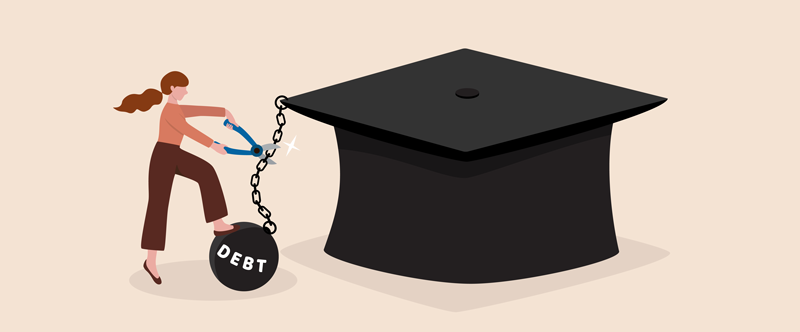
By Dee Baskin and Heather Vlieger
Enacted in 2007 with bipartisan support, the Public Service Loan Forgiveness (PSLF) Program is the bridge between low public service salaries and overwhelming levels of education debt. PSLF forgives the remaining balance on federal Direct Loans for public servants after certain conditions are met. The program is especially important for public interest lawyers who require a J.D. for their public service work. Law graduates often have six-figure education debt, while entering public sector jobs with $55,000 starting salaries.
Unfortunately, the PSLF Program has been plagued with problems—causing fewer than two percent of applicants to receive forgiveness. Two federal programs are in place right now to help borrowers seeking PSLF. First, federal loan forbearance under the CARES Act has paused federal loan payments and provided 0% interest rates through May 1, 2022. Second, the U.S. Department of Education (ED) announced a temporary period during which borrowers may receive credit for payments that previously did not qualify for PSLF. The temporary waiver period expires October 31, 2022.
Below are the latest updates on federal loan forbearance, a refresher (or new information for lawyers who may not have paid loans at all since starting their employment) on what happens when forbearance ends after May 1, 2022, and what steps to take for the temporary waiver.
Current status of federal student loans
Under the current loan forbearance, which began on March 13, 2020, federal student loans are subject to no interest, no payments, and no collection activities (private student loans are not included). For those seeking PSLF, the suspended payments also count toward PSLF as long as the other program requirements are met. By May 2022, borrowers will have 25 payments toward the 120 payments needed for forgiveness.
Once federal loan forbearance ends on May 1, 2022, student loans will mostly return to pre-March 2020 status. Payments, interest accrual, and collection activities will resume. U.S. Treasury Offset Program activities (such as withholding of tax refunds and social security benefits) are paused for student loans in default until November 1, 2022.
An important change to prepare for is the change in loan servicers for PSLF from FedLoan to MOHELA. A comprehensive list of steps to follow is on the Minnesota Legal Services State Support website. The top priority for all borrowers is to pull loan payment history and ensure contact information is updated. This pause is an ideal time to gather every letter, screenshot, email, and bank statement and create a system to document loan payments until PSLF is achieved. If anything goes awry during the transfer or with loan payments in the future, this documentation is necessary to correct discrepancies.
What happens after May 1, 2022
With the exception of the temporary waiver program, when forbearance ends and student loans return to business as usual, the five steps to make consistent progress toward PSLF are:
- Right kind of payment
- Right kind of loan
- Right kind of job
- Repeat 120 times
- pRove it
Tax free loan repayment assistance is available for certain public interest lawyers—support LRAP Minnesota to continue this work, or learn more about eligibility and applying for assistance.
Right kind of payment
The right kind of payment for PSLF is a payment that is made on time, in full, while on an income driven repayment plan.
On-time payments are made within 15 days of the due date (before or after). Paying in full means paying the required payment amount based on the borrower’s repayment plan. Income driven repayment plans are based on family size and other factors. There are several options for income driven repayment plans (such as PAYE, REPAYE, or IBR) which can be explored via the Loan Simulator tool.
Right kind of loan
The loans that qualify for PSLF are federal direct loans and direct consolidation loans.
Right kind of job
The right kind of job for PSLF is full time, paid work with qualifying employer(s). Qualifying employers include not-for-profit organizations that are tax-exempt under Section 501(c)(3) of the Internal Revenue Code (such as free legal services providers), several types of government workers (judicial clerks, public defenders, prosecutors), and those serving as a full-time AmeriCorps volunteers.
Full time is an annual average of at least 30 hours per week (for one or more qualifying employers) or the number of hours the employer considers full time (for one employer).
Repeat 120 times
The 120 payments made after October 1, 2007 qualify for PSLF. These payments do not need to be consecutive.
pRove it
Documentation may be necessary to prove loan payments meet the above requirements (or the requirements of the waiver detailed below). Borrowers seeking PSLF should keep all documentation until PSLF is achieved.
New resource for Minnesota student loan borrowers
For problems or issues with student loans, including private lenders or complaints about student loan servicers, the Minnesota Department of Commerce has information about the Student Loan Borrower Bill of Rights.
How to access the PSLF Temporary Waiver
The Public Service Loan Forgiveness Waiver is a temporary federal program designed to help public service workers, including attorneys, get their federal student debt forgiven. These benefits end on October 31, 2022, so it is critical for borrowers to act right away if they may benefit from this waiver opportunity. The PSLF waiver opportunity expands eligibility in several key ways. First, the waiver makes additional federal loans like Federal Family Education Loans (FFEL) and Perkins Loans qualify. Borrowers will need to consolidate these into Direct loans and then apply for PSLF. Second, any repayment plan will qualify, and the definitions of “on time” and “in full” have been relaxed. In essence, the Department of Education will seek to confirm that the PSLF applicant was in repayment status during the qualifying period.
Some requirements remain the same, a successful PSLF applicant needs to have worked full-time in qualifying employment for 120 payments. Payments on or after October 1, 2007 qualify. And each month during the student loan pause due to the pandemic will count as qualifying payment if the applicant otherwise qualifies for PSLF.
Here are the next steps for borrowers who may benefit from the PSLF Waiver opportunity:
- Go to the Federal Student Aid website, login with a Federal Student Aid ID, and confirm up to date contact information.
- A borrower with Direct Loans and 120 payments who has not previously applied should apply for PSLF right away. Tip: Before applying, request a payment history record from the current loan servicer.
- Borrowers with FFEL or Perkins loans should consolidate into a Direct Loan, then apply for PSLF. Go to the National Student Loan Data System (NSLDS) website and login with a Federal Student Aid ID to confirm types of student loans.
Visit the PSLF Coalition’s Temporary Waiver page to learn more about the waiver opportunity.
Emily Good has been a public interest attorney for 18 years, and currently works at Minnesota Legal Services State Support. Emily said, “When PSLF first became available, I thought it was so great but was really disappointed it wasn’t an option for me. This PSLF waiver felt like a gift, to find out that all the years of work that I was doing anyway, would qualify.”
Emily adds, “I feel lucky that PSLF will give me more financial security, and also the ability to save more for retirement.” Emily is currently waiting for her application to be reviewed, and shares this advice with others, “I’d encourage folks who apply or are currently waiting (like me) to keep calm and appreciate how many more files are getting processed and approved.”
 Dee Baskin
Dee Baskin
dbaskin@mnbars.org
Dee Baskin (she/they) is a communicator, educator, advocate, and queer person of color with a deep commitment to justice and equity. Dee is the Executive Director of Loan Repayment Assistance Program of Minnesota (lrapmn.org), a 50(c)3 nonprofit helping legal aid attorneys pay their student loans until they reach Public Service Loan Forgiveness (PSLF)--ensuring that skilled and dedicated advocates are here to serve the low-income Minnesotans who need them most. Dee graduated from the University of Minnesota Law School in 2010 and has a Bachelor’s in English and Public Relations from the University of Indianapolis.
 Heather Vlieger
Heather Vlieger
hvlieger@mylegalaid.org
Heather Vlieger is the Grants Manager at Mid-Minnesota Legal Aid. She has previously worked as the Executive Director of the Loan Repayment Assistance Program of Minnesota and the Program Manager of the Minnesota Justice Foundation. Heather is a graduate of Indiana University School of Law.